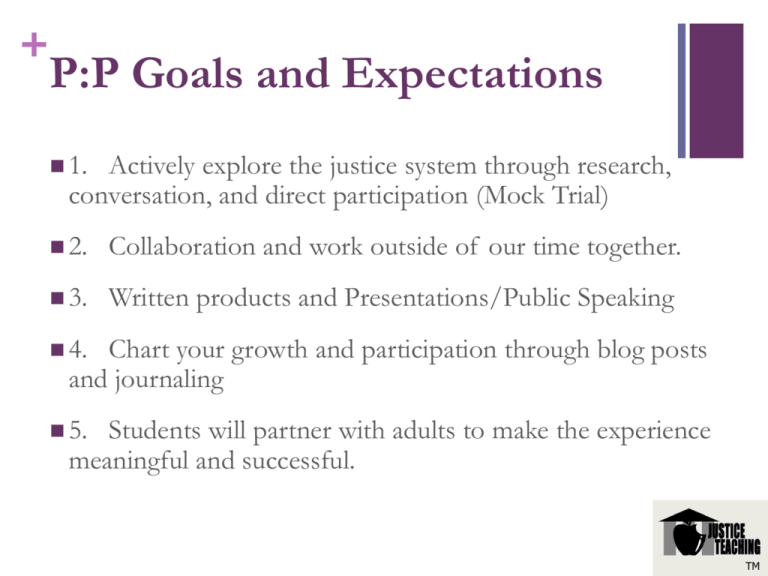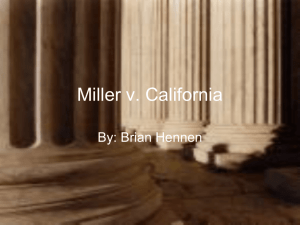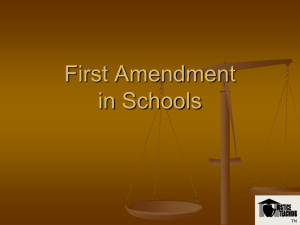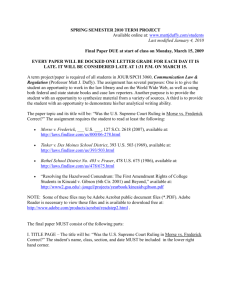File
advertisement

+ P:P Goals and Expectations 1. Actively explore the justice system through research, conversation, and direct participation (Mock Trial) 2. Collaboration and work outside of our time together. 3. Written products and Presentations/Public Speaking 4. Chart your growth and participation through blog posts and journaling 5. Students will partner with adults to make the experience meaningful and successful. TM + Morse v. Fredrick A Case Study in Judicial Decision Making First Amendment in Schools TM + Goals and Expectations 1. Define speech; 2. Explore the boundaries of free speech; 3. Analyze the First Amendment; 4. Apply the First Amendment and case precedent to specific case studies; 5. Experience the judicial decision-making process. TM + First Amendment shall make no law respecting an establishment of religion, or prohibiting the free exercise thereof; or abridging the freedom of speech, or of the press; or the right of the people peaceably to assemble, and to petition the Government for a redress of grievances.” “Congress TM + First Amendment Can you identify the five rights in the First Amendment? TM + First Amendment The Five Rights Freedom of speech Freedom of religion Freedom of the press Right to assemble peacefully Right to petition the government TM + What is Speech? Anything that a person says or does that is intended to convey a message that could reasonably be expected to be understood by others. TM + What is Speech? Speech can be non-verbal, such as displaying a flag. Stromberg v. California, 283 U.S. 359 (1931) Obscene speech is not protected. Miller v. California, 413 U.S. 15 (1973) The school environment is different from the public in that schools have the duty to fulfill their educational mission. Tinker v. Des Moines, 393 U.S. 503 (1969) TM + Prior Decisions Decisions of the US Supreme Court Case precedent and free speech TM + Miller v. California (1973) Miller conducted a mass mailing campaign of“adult material.” He sent five unsolicited advertising brochures through the mail to a restaurant. The manager of the restaurant and his mother opened the envelope containing the brochures and complained to the police. Miller was arrested and convicted of a state statute that prohibited knowing distribution of obscene material. The TM appellate court affirmed Miller’s conviction. + Miller v. California (1973) The United States Supreme Court vacated Miller’s conviction and remanded. The Court held that material is unprotected by the First Amendment.” Therefore, obscene material may be regulated by the states, but subject to certain safeguards. What is obscene is to be determined by state community standards (i.e., what is obscene in Utah may not necessarily be obscene in New York state). The Supreme Court remanded the case so that the lower court could consider Miller’s case under these new standards. “[O]bscene TM + Other Relevant Cases Stromberg v. California Tinker v. Des Moines Bethel School District v. Fraser Hazelwood S.D. v. Kuhlmeier These cases are to be explored during your homework period this evening. TM + School vs. Public The Court has recognized that students do not shed their constitutional rights when they enter school. However, the Court has traditionally recognized that the educational mission of the school cannot be disrupted by the exercise of free speech. Speech rights at school differ from outside the school environment. TM + First Amendment Today’s Case – Morse v. Fredrick You will be the justices on the US Supreme Court to decide the First Amendment case presented today. TM + Morse v. Fredrick TM + Morse v. Frederick What are the facts of the case? What did the principal do? TM + Morse v. Frederick Read the case materials provided and circle or highlight any and all important facts. TM + Morse v. Frederick Review US District Court and Ninth Circuit decisions. US Supreme Court grants certiorari Does the First Amendment allow public schools to prohibit students from displaying messages promoting the use of illegal drugs at school-supervised events? TM + Supreme Court Conference the 1st Amendment … what does it mean? … and then discuss why the assigned precedent case is considered a 1st Amendment case. Articulate Construct a case brief to organize ideas, determine the facts of the precedent case that was assigned … use this to aid in presenting/sharing your knowledge. Establish a personal opinion about the precedent case and determine its connection/link to Morse v. Fredrick Break / Game / Introduce Blogging and Academic Writing Expectations TM + Supreme Court Conference Break / Game / Introduce Blogging and Academic Writing Expectations Present the 4 precedent cases Deliberation How and Decisions – how will your court choose to vote? did the US Supreme Court rule on June 25, 2007? Homework … Blogs TM + Morse v. Frederick Yes The US Supreme Court reversed the Ninth Circuit by a 5-4 decision ruling that school officials can prohibit students from displaying messages that promote illegal drug use. The majority held that the message although cryptic was reasonably interpreted as promoting marijuana use. TM + Morse v. Frederick Three dissenting justices concluded that“the school’s interest in protecting its students from exposure to speech ‘reasonably regarded as promoting illegal drug use’ cannot justify disciplining Frederick for his attempt to make an ambiguous statement to a television audience simply because it contained an oblique reference to drugs.” TM +Morse v. Frederick The dissent believed that student speech is protected if the message itself “neither violates a permissible rule nor expressly advocates conduct that is illegal and harmful to students,” and concluded that Frederick’s“nonsense” banner did neither. Justice Breyer wrote separately and expressed his belief that the majority should not have addressed the First Amendment issue at all, but instead, resolved the case on alternative grounds. TM + Morse v. Frederick Here is how the Court ruled: Red voted with majority decision Blue were dissenters (Justice Breyer for a different reason) TM




